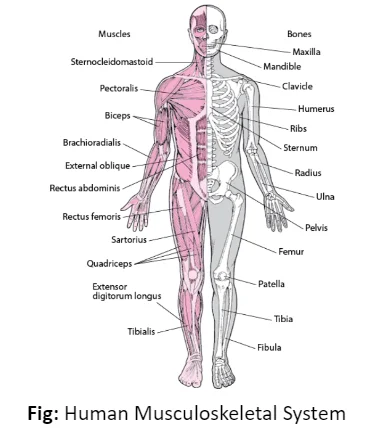The musculoskeletal system is crucial for our body’s movement and structure. Muscles, bones, and joints work together to support us and enable movement. Muscles make up a significant portion of our body weight and have unique properties like excitability and contractility. There are different types of muscles, including skeletal, smooth, and cardiac muscles, each serving specific functions in our body.
An Overview Of Musculoskeletal System
Muscles
- Muscle Tissue: Muscles are specialised tissue of mesodermal origin (contributing 40-50 % of body weight in adults).]

- Properties of Muscles: Have special properties like excitability, contractility (involves ions like Ca++, Na+), extensibility and elasticity.
- Types of muscles:
- Skeletal muscles: These are attached to bones (responsible for skeletal movements) and are controlled by the peripheral portion of the central nervous system (CNS).
- Hence, they are voluntarily/consciously controlled.
- The muscle fibre with many nuclei (the basic unit of these muscles) is striated (has transverse streaks), and each fibre acts independently of the neighbouring fibre.
- Smooth muscle: It is found in the walls of the hollow internal organs such as blood vessels, the gastrointestinal tract, bladder, and uterus.
- It is under the control of the autonomic nervous system
- It is involuntary, slow and rhythmic.
- The non-striated (smooth) muscle cell is spindle-shaped and has one central nucleus.
- Cardiac muscle: It (found in the walls of the heart) is also under the control of the autonomic nervous system.
- The cardiac muscle cell has one central nucleus, like smooth muscle, but it also is striated, like skeletal muscle.
- The contraction of cardiac muscle is involuntary, strong, and rhythmical.
Skeleton
- The Human skeleton (an internal skeleton) serves as a framework for the body and consists of many individual bones and cartilage along with bands of fibrous connective tissue– the ligaments and the tendons.
- The human skeleton consists of two principal subdivisions:
- Axial Skeleton: comprising the vertebral column (spine and much of the skull.
- Appendicular Skeleton: to which the pelvic (hip) and pectoral (shoulder) girdles and the bones and cartilages of the limbs belong.
- Joints: Joints are points of contact between bones, or between bones and cartilages essential for movement and are classified into three major structural forms:
- Fibrous Joints: do not allow any movement and are shown by the flat skull bones which fuse end-to-end to form the cranium.
- Cartilaginous Joints: joints between the adjacent vertebrae, the bones involved are joined together with the help of cartilages permitting limited movements.
- Synovial Joints: help in locomotion and many other movements and are characterised by the presence of a fluid-filled synovial cavity between the articulating surfaces of the two bones allowing considerable movement.
- Examples: The ball and socket joint (between the humerus and pectoral girdle), hinge joint (knee joint), pivot joint (between atlas and axis), gliding joint (between the carpals) and saddle joint (between carpal and metacarpal of thumb)
- An infant’s body has about 300 bones at birth, which eventually fuse to form the 206 bones that human adults have.
Conclusion
- The musculoskeletal system forms the framework of our body, enabling us to move and perform various activities.
- It consists of muscles, bones, and joints, each playing a vital role in maintaining our body’s structure and facilitating movement.
- Understanding the functions and components of the musculoskeletal system helps us appreciate its importance in our everyday lives and overall health.
![]() June 5, 2024
June 5, 2024
![]() 2913
2913
![]() 0
0
